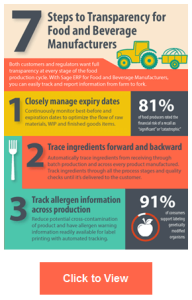Consumer demands and industry regulations drive transparency for food and beverage manufacturers
Transparency was once a concept, then a buzzword, now it is part of daily operations for food and beverage manufacturers. Transparency has come full swing from organic food labeling to grown locally, GMO labeling, clean  labels, and even the demands by the FDA with the 2015 Food Safety and Modernization Act (FSMA).
labels, and even the demands by the FDA with the 2015 Food Safety and Modernization Act (FSMA).
This is a new age of transparency that isn’t just about recalls and consumer demands but about having the ability to track materials and finished goods up and down the supply chain, from procurement through and into the customer’s hands. Leslie Turner, general counsel for The Hershey Co., said during her keynote speech at the 2015 Food Integrity Summit,
“If we don’t embrace transparency ourselves, it will most likely be trust upon us in ways that are not positive.”
Major brands are starting to make the shift to becoming transparent not only because consumers are concerned with where their food is coming from but also food recalls such as the ones that have plagued Chipotle, can make or break a brand. By staying more in control of the public discussion companies can benefit from transparency by building trust and loyalty.
Transparency also carries over into business practices. Most small food and beverage companies start out with QuickBooks and Excel. Which makes sense at first, but as you start to scale it becomes hard to analyze data, you are really just collecting it. Next you add an inventory management solution such as Fishbowl. Now you are starting to build out a system of disparate solutions. Resulting in double/manual entry, painful download and upload times, and lack of built-in safeguards to guarantee processes are being followed.
What happens if there is a recall? How quickly can you sift thru your disparate spreadsheets and your various business management systems to determine where the issue happened in the product life-cycle? With Sage software, you can automatically trace ingredients from receiving through batch production and across every product manufactured. Sage business management solutions allow you to track ingredients through all the process stages and quality checks until it’s delivered to the customer. Take our transparency quiz to see how your business practices rank.



